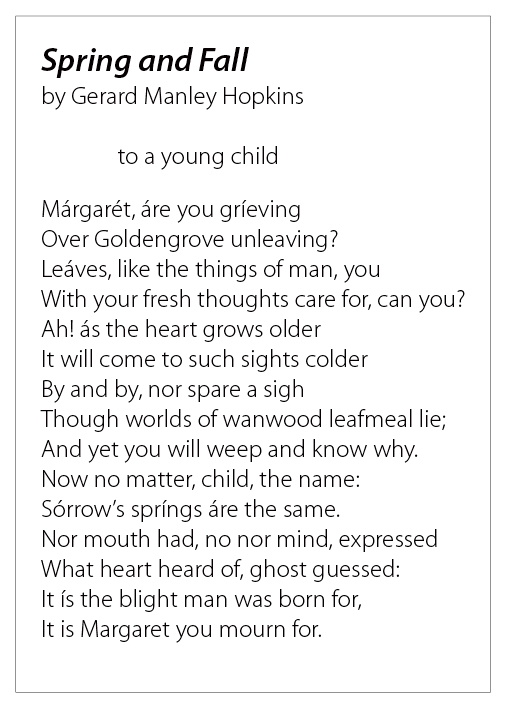By Clover Carroll
As I sit on my porch bidding farewell to the hummingbirds and admiring the colorful arrival of my favorite season, this poem often comes to mind. No other autumn poem I know captures fall’s simultaneous feelings of loss and wonder as poignantly as this one. We cherish this fleeting season precisely because it is bittersweet: the brilliant cascade of colored leaves is a harbinger of the dark, cold monotony of impending winter.
This inherent sadness in the season is intuited by young Margaret, the child addressed in “Spring and Fall,” whom the poet finds weeping in a woodland as she witnesses the falling of the leaves and the resultant exposure of the skeletal trees.
Autumn is often used in literature as a symbol of aging, of leaving youth behind and beginning the inevitable march toward death. In this gem of a poem, British poet Gerard Manley Hopkins (1844-1889) develops this symbolism through double meaning, musical language, and unique rhythmic effects to offer a profound meditation on death and the human condition.
The poet begins by seeming to offer comfort to the child, asking her why she is crying. The striking word “Goldengrove,” since it is capitalized, may refer to a specific English estate, but it also evokes the image of any grove of trees decked out in autumn colors of gold and orange. The word “unleaving” suggests that summer is leaving, as well as being a concise and original way to describe the loss of leaves, which are compared to all worldly “things of man” which the young girl has already learned, in her short life, to care for deeply.
The poet reflects that in her “fresh” youth—perhaps embodying the Spring of the title—the child cannot know what pain lies ahead in her life. He predicts that as she grows older, she will become so hardened by experience that she will no longer lament (“sigh”), even if an entire forest were to be cut to pieces: “though worlds of wanwood leafmeal lie.” Wan means pale, but also connotes weakness and sickness, almost anthropomorphizing the trees and suggesting a troubled world. He realizes, however, that she demands an explanation for the seeming tragedy of defoliation: “you will weep and know why.”
At this point in the poem (line 10), the poem turns from question to answer. Instead of comforting her, however, the poet attempts to explain the true source of her sadness, and this explanation is not, in fact, comforting at all. A more sentimental response might be to reassure the child that the annual death of leaves and flowers that results in the loss of our green arbor of shade is only temporary, because they will all return in the spring. But the poet reverses the expectation that he might celebrate the season of spring created by the title. Instead, his cold consolation is that we all share the same source of sadness she is feeling, and it is permanent: “sorrow’s springs are the same.”
Though neither her mind nor her mouth could form the thought, her heart and spirit (“ghost”) know instinctively that all mortal things, including Margaret herself, must inevitably die. Moreover, “the blight that man was born for” suggests the fall of man into original sin that occurred in the Garden of Eden, which in this poet’s view is the true wellspring of all sorrow during this transitory life. Thus the “fall” of the title has a double meaning, and the falling leaves have taken on a cosmic importance as we realize that Margaret, as young as she is, is mourning not only her own impending death, but also her loss of innocence, her flawed nature, and the fallen state of mankind as a whole.
This fundamental paradox between beauty and grief in nature is reinforced by Hopkins’ skillful use of musical effects. The sonnet is presented in rhyming couplets, which complement the tone of childish wonder and disappointment. There is not a line in the poem that does not contain an aural surprise or sleight of hand (sleight of ear?), from the internal rhyme of “by and by” with “spare a sigh” in line 7 to rhyming “mourn for” with “born for” in line 14 (Cole Porter, come in please!). Extensive alliteration underlies the poem’s musicality, from grieving/Goldengrove and “care for, can you” in the opening lines to “worlds of wanwood,” “sorrow’s springs,” and heart/heard, ghost/guessed in the conclusion.
Assonance—the echoing of vowel sounds within lines—is also prevalent, for example in the “o” sounds of Goldengrove/older/colder and the “ee” sounds of “leafmeal/weep.” These soft sounds help to create a mood of sadness, and the abundance of musical effects pleases our ears.
But the most notable sound effect is the meter, an instance of Hopkins’ own invention that he called “sprung rhythm.” He wrote in Old-English-inspired half-lines, with each half-line containing one stressed syllable regardless of the number of unstressed syllables—leading to an uneven number of traditional feet in each line and an unusual, emphatic quality.
“Spring and Fall” is not a nature poem so much as a theological reflection on the human condition. Hopkins, a deeply religious Jesuit priest, was raised in Protestant England but converted to Catholicism at age 21 and later became a professor of Greek in Ireland. Although a contemporary of well-known Victorian poets Tennyson and Browning, Hopkins’ poetry was not known in his lifetime, but published posthumously in 1918. His highly original poems, such as “God’s Grandeur” and “Pied Beauty,” reflect a more modern sensibility and sensitivity than traditional Victorian poetry.
We were all young once, and have all experienced the loss of innocence and the accompanying intense nostalgia depicted in this poem. Yes, we are grieving with the earth as it weeps its leafy tears—not only for our lost youth and innocence, but for the inevitable loss of this glorious, precious life that we, like Margaret, must leave someday.












